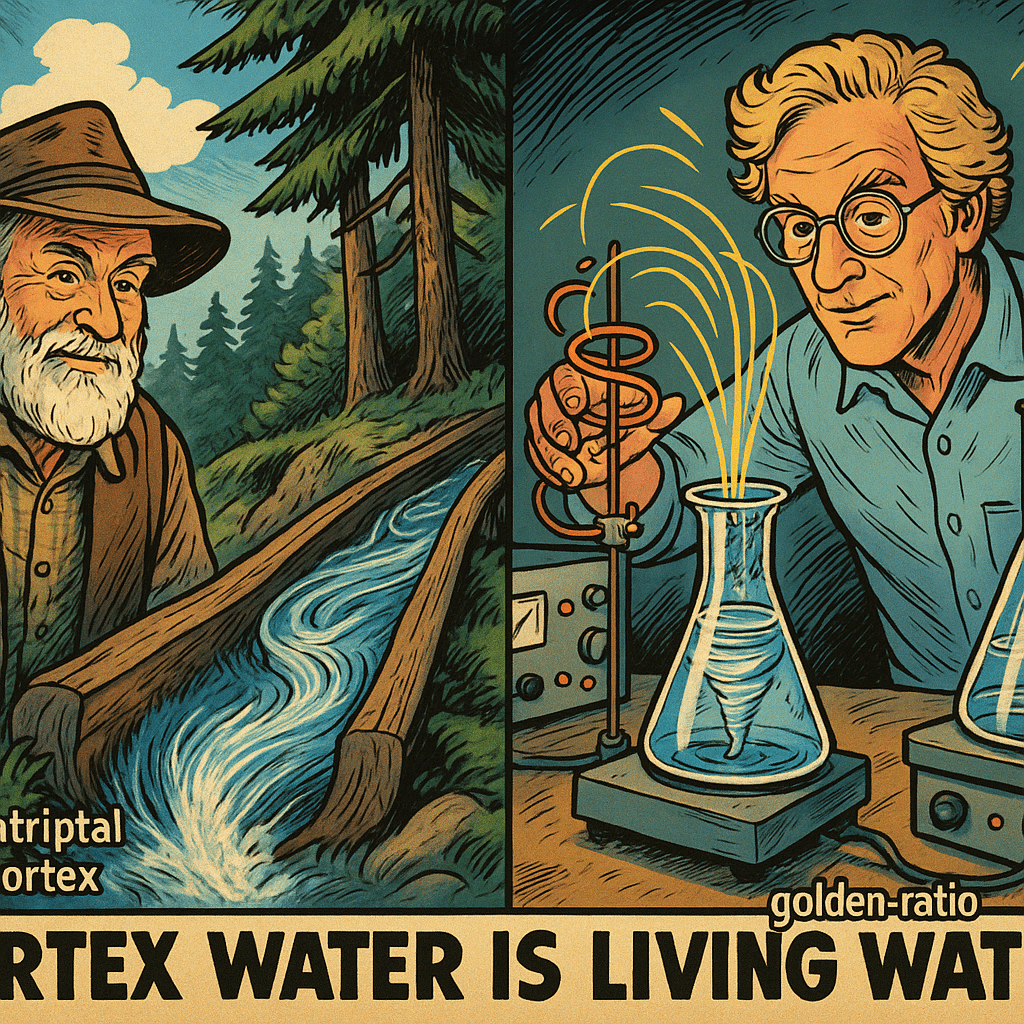DIY Water Vortexing for Phi Phi Health
Here’s a practical, no-nonsense path to “vortexed” drinking water in the spirit of Viktor Schauberger (cool, shaded, centripetal/egg-shaped flow) and Dan Winter (golden-ratio/phase-conjugate geometry). From simplest to most capable, with exact build tips.
First principles (why we’re doing these shapes/motions)
- Centripetal vortex in cool water: Schauberger emphasized egg/tear-drop forms that induce inward (implosive) vortices; he associated these with cooling/ordering vs. chaotic “explosive” turbulence. (library.uniteddiversity.coop, alkimist.net, ia802907.us.archive.org)
- Alternating spin / pulsing: Flowform vessels deliberately make water pulse and alternate clockwise/counter-clockwise to “revitalize” flow; regardless of metaphysics, this reliably mixes and aerates. (ebbandflowltd.co.uk, bohemianstoneworks.com, bohemianstoneworks.com, TrueSpring, TrueSpring, biodynamictrainee.com)
- Why it can taste better: Controlled vortices increase gas exchange and micro-mixing, boosting dissolved oxygen compared to many simple aerators. (Peer-reviewed engineering shows vortex/hyperbolic funnels and vortex aerators can be highly efficient for O₂ transfer.) (MDPI, ScienceDirect, E3S Conferences, ACS Publications)
- Golden-ratio geometry (Winter-style): If you want to incorporate phi (φ≈1.618) proportions and “phase-conjugate” ideas, shape ratios and opposing spirals are the design cues people use. (These claims are speculative, but you can still build to φ.) (fractalfield.com, www.slideshare.net, psicogeometria.com)
Quick wins (5 minutes, <\$100)
- Hand-swirl in a φ carafe (zero power).
Use a golden-ratio glass carafe with a narrow neck and bellied body; fill with cool water (40–50 °F / 4–10 °C), stir 2–4 minutes, reverse for 30–60 s, then let it rest 1–2 minutes before pouring. (Watermatters, naturesdesign.nz) - Magnetic-stir vortex in a conical/egg vessel.
Place a PTFE-coated stir bar in a tall conical/egg-like glass (Erlenmeyer, Florence, or egg decanter), run a basic lab stirrer just fast enough to pull a clear vortex to ~½–⅔ depth, then reverse briefly. This maximizes vortex without “boiling” turbulence—great for oxygenation and mouthfeel. (MDPI)
DIY builds (Schauberger/Winter cues baked in)
A) Counter-rotating tabletop vortexer (no pump)
Materials
- 1–1.5 L egg/phi-ratio glass vessel (height\:diameter ≈ 1.6:1).
- Magnetic stir plate + 30–40 mm PTFE stir bar.
- Optional: a printable helical vane insert that hugs the inner wall to guide an inward spiral; food-safe (smooth PETG sealed with food-safe epoxy) or glass.
- Lid or splash guard.
Steps
- Chill water to 4–10 °C (Schauberger’s “densest water” zone). Fill vessel to the widest diameter. (library.uniteddiversity.coop)
- Spin clockwise 2–3 min, just deep enough to see a clean funnel; reverse 30–60 s.
- Let rest 1–2 min to settle bubbles; pour.
- For a Winter-style touch, size the vessel so height ≈ 1.618 × max width and keep the helical vane pitch so that one full turn drops by φ×diameter (a φ-based “implosive” spiral). (fractalfield.com, www.slideshare.net)
Why it works: You get a stable Rankine-like vortex with high surface renewal (O₂ transfer) without over-shearing. (MDPI)
B) Inline recirculating egg-chamber vortexer (counter-spin loop)
Use when you want 2–5 L structured at a time.
Materials (all food-safe)
- Chamber: borosilicate or 316SS egg-shaped body, H\:W ≈ 1.6:1 (φ). Two tangential ports; one axial drain at bottom.
- Pump: small food-grade head (quiet diaphragm or centrifugal).
- 3/8″ silicone tubing, valves to control flow, and a bypass tee for counter-rotation pass.
- Optional inline sediment filter (10–20 µm).
Plumbing
- Tangential IN at upper third; axial OUT at bottom to recirculate.
- Add a second tangential IN opposite handedness via a bypass so you can flip the spin for 20–40 s each cycle.
- Aim tangential port angle at 15–20° to wall; target Re just high enough for a stable deep vortex (practically, tune by eye).
Cycle
- Run clockwise 3–5 min (cool water).
- Flip valve to cross over and counter-rotate 30–60 s.
- Rest 1–2 min; dispense.
Notes: The egg body and tangential entry are straight Schauberger cues; the spin-flip borrows from Flowform alternation to add pulsing and mixing. (library.uniteddiversity.coop, ebbandflowltd.co.uk)
C) Micro-Flowform cascade (gravity only)
Use when you want the gentlest handling + rhythmic pulsing.
Materials
- Two or three paired basins that hand water off in alternating vortices (CW → CCW → CW…). Choose glazed ceramic/stone or food-safe cast.
- Mount with a drop of ~8–12 cm per stage; keep channels smooth.
Operation
- Pour chilled water at a steady rate so each bowl forms a clean side vortex before spilling to the next. Collect in a glass reservoir.
This reproduces the Wilkes/Flowform pulse; it’s slow, quiet, and elegant. (ebbandflowltd.co.uk, bohemianstoneworks.com)
A “phi spec” you can follow
- Chamber H\:W ≈ 1.618:1 (Winter-style φ embedding). (fractalfield.com)
- Neck ≈ 0.618 × max width to help centripetal pull.
- Tangential port height ≈ 0.618 × H, angle 15–20°.
- If you prefer a ready-made “phi vessel,” the popular Alladin/φ carafes are sized by golden ratio (just use them as the mixing body). (Watermatters)
- There’s even IP around egg-shaped, golden-section flow-through devices—useful for sketching your own. (Google Patents)
Operating protocol (tastes clean, no woo needed)
- Cool your water (fridge or ice bath) to 4–10 °C. (library.uniteddiversity.coop)
- Vortex 2–5 minutes; avoid “boiling” turbulence.
- Reverse spin briefly (20–60 s).
- Rest 1–2 minutes (bubbles rise; mouthfeel smooths).
- Drink fresh; don’t store in sun/heat.
Materials & safety (important)
- Best: borosilicate glass, glazed ceramic, 316 stainless, silicone tubing.
- Copper is a Schauberger favorite for shaping flow, but sustained contact can leach Cu at low pH—keep water neutral, contact time short, or keep copper outside the wetted path (e.g., external coil purely for thermal shaping). (Permies)
- Use food-safe sealants only; clean with hot water and percarbonate (no perfumed detergents).
To go “full Winter”
Add φ-ratio dimensions throughout, use counter-rotating paired spirals, and (optionally) place the device between opposed dielectric plates or coils arranged to a pent/dodeca/φ pattern. The physics claims are contested, but it gives you a coherent, reproducible build spec. (fractalfield.com, www.slideshare.net)

STL CAD FILE FOR 3D PRINTING
Produce it. Clamp it together with stainless worm clamp. In and Out are standard 1/2 pipe compatible.